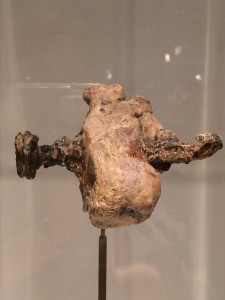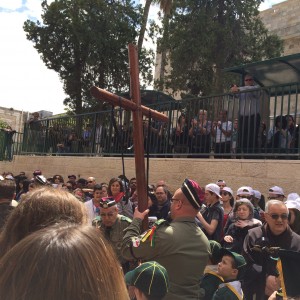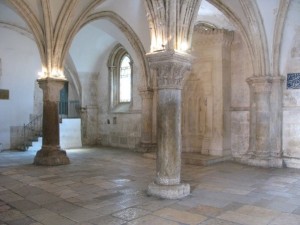by Michael D. Rhodes
In Paul’s first letter the Corinthians, he had to deal with the claim made by some of the members at Corinth that there was no resurrection from the dead (1 Cor. 15:12). In response to this he refers to the fundamental principles of the Gospel that he had taught them: “that Christ died for our sins … that he was buried, and that he rose again the third day” (1 Cor. 15:3-4). Paul then refers to the many people who saw the resurrected Christ. He begins with Peter, whom he calls “Cephas” (1 Cor. 15:5), which was the leading Apostle’s nickname.[1] The next witnesses Paul mentions are “the twelve [apostles]” (1 Cor. 15:5). The New Testament confirms his point describing several occasions where Christ appeared to the apostles shortly after his resurrection (see Matt. 28:9, 18; Luke 24:15, 36-50, John 20:19-23, 26-29; 21:4-23; Acts 1:3).
Paul then refers to an appearance of Christ “to more than five hundred brothers and sisters[2] at one time, of whom most are still alive, although some have fallen asleep” (1 Cor. 15:6, author’s translation). This remarkable appearance of Christ to such a large group of people is not mentioned anywhere else in the New Testament. This appearance must have been similar to Christ’s appearance to the Nephites (3 Ne. 11:8–10), where men, women, and children were all present. It is notable that Paul states that most of these witnesses were still alive at the time of his writing, approximately 55 AD, more than twenty years after the event.
The next person Paul calls upon as a witness is James (1 Cor. 15:7). This is most likely James, the half-brother of Christ[3] and author of the Book of James, rather than one of the two original apostles named James.[4] Early Christian tradition maintains that it was Christ’s appearance to James that converted him.[5] James’ experience parallels rather closely the conversion of Paul himself. The event, in a revolutionary way, produced a strong conversion in both apostles.[6]
Paul then says that Christ was seen by “all the apostles” (1 Cor. 15:7). The word “apostle,” in this instance, seems to refer not only to the original members of the Twelve, whom Paul has already mentioned, but also to those who—like James, the brother of Christ; Jude; Barnabas; and perhaps others we do not know of—were ordained to the holy office of Apostle; those men who were charged with and set apart for bearing special witness of the Lord Jesus Christ.
As a final witness, Paul states, “last of all he was seen of me” (1 Cor. 15:9). The phrase “last of all,” should not be taken to mean that Paul saw himself as the last person who ever saw the risen Lord. He is rather saying that, on his list, he is the last witness he will mention. It is of note that Paul lists Peter as the first witness with himself as the last. In doing so, he ties both of them together. Of all these appearances, the most personal to Paul is, of course, Christ’s appearance to him. As President Howard W. Hunter noted:
“Thus Paul adds his personal witness, referring to his experience on the way to Damascus when he was suddenly changed from a persecutor to one of the greatest exponents. He refers to himself as ‘one born out of due time.’ . . . His dramatic change and conversion is used in his argument as the final point to prove the actual resurrection of Jesus. Paul was anxious that the saints would not only believe, but should never have the least doubt as to this basic fact upon which eternal life hinges.”[7]
Though Paul may have been able to mention more appearances of the Lord, he lists enough to defuse any idea that only a scattered few witnessed the event. Indeed, the Apostle presents “a formidable gallery of witnesses waiting to testify they that have seen [the Lord] alive.”[8] The appearance to more than five hundred Saints at one time—most of whom were still alive and could, therefore, verify the experience—was a tremendous witness to the reality of the Resurrection.
To Paul’s list of witnesses of Jesus’ resurrection, Latter-day Saints also add the witness given in the Book of Mormon. The resurrected Savior descended out of heaven and visited his faithful followers in the New World. During this visit, he taught them the gospel, healed the sick and gave blessings, instituted the sacrament, and called twelve disciples to lead the church in their land. These witnesses of the Savior provided the foundation for an era of unprecedented peace in that land.
[1] Danker, Frederick William, ed. A Greek-English Lexicon of the New Testament and Other Early Christian Literature. 3d ed. (Chicago: University of Chicago Press, 2000). 544. Cephas is the Greek rendering of כֵּיפָא (kēypā’), Aramaic for “the rock,” The English transliteration of the Apostle’s nickname “Peter” comes from the Greek πέτρος (petros), which is the masculine form of πέτρα (petra), “rock,” a designation the Savior gave the fisherman the first time they met (John 1:42). Identifying the importance of this title, the Joseph Smith Translation notes that the word has reference to a “seer stone,” thus, the nickname foreshadowed Simon’s eventual Church leadership as its Seer. See also Matt. 16:18; compare D&C 10:69; 33:13.
[2] The Greek noun ἀδελφοί (adelphoi), which the King James Version translates as “brethren,” can also include females, and is here better translated as “brothers and sisters.”
[3] Galatians 1:19.
[4] Matt. 10:2; Mark 3:16; Luke 6:14; Acts 1:13.
[5] Bruce, F. F. Men and Movements in the Primitive Church (Exeter: Paternoster, 1979), 86–119; see also the study by Walter Schmithals, Paul and James, trans. Dorothea M. Barton (London: SCM Press, 1965). A pseudepigraphical account of this visit can be found in Gos. Heb. §7. Jerome, vir. ill, 2, also tells the story of such a meeting.
[6] Bruce, Men and Movements, 87; compare Archibald T Robertson., and Alfred Plummer, A Critical and Exegetical Commentary on the First Epistle of Paul to the Corinthians. 2d ed. (Edinburgh: T and T Clark, 1958), 338.
[7] Howard W. Hunter, in CR, April 1969, 137.
[8] Richard B. Hays, First Corinthians. Interpretation: A Bible Commentary for Teaching and Preaching. (Louisville, Ky.: John Knox Press, 1997), 257. See also Fee, Gordon D. First Epistle of the Corinthians. The New International Commentary on the New Testament. (Grand Rapids, Mich.: Eerdmans, 1987), 729–30.





